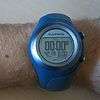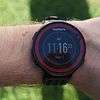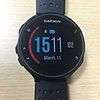Garmin Forerunner
|
Garmin Forerunner 205 being worn | |
| Manufacturer | Garmin |
|---|---|
| Display | Digital |
| Introduced | 2003 |
The Garmin Forerunner series is a selection of sport watches produced by Garmin. Most models use the Global Positioning System (GPS), and are targeted at road runners and triathletes. Forerunner series watches are designed to accurately measure distance, speed, heart rate (optional), time, altitude, and pace, all of which can be important to athletes in training.
Models
The Forerunner series consists of the 101, 201, 301, 205, 305, 50, 405, 60, 405CX, 310XT, 110, 210, 410, 610, 910XT, 70, 10, 220, 620, 15, 920XT, 225, 25, 230, 235, 630, 735XT, 35 (listed in chronological order by release date). All models except the 101 include a way to upload training data to a personal computer and training software.[1]
Garmin registered the name "Forerunner" with the United States Patent and Trademark Office in August 2001 but released the first watches — the 101, 201, and 301 — in 2003.[2]
In 2006, the improved 205 and 305 appeared. These models are smaller than the first generation and feature a more sensitive SiRFstarIII GPS receiver chip.
In late 2007, the Forerunner 50 was introduced. As opposed to GPS, this model paired with a foot pod to measure displacement. The Forerunner 50 also came packaged with a USB stick that allowed training data to be transferred wirelessly to one's pc.[3] This feature has since become a staple of Garmin's more full-featured sport watches.
The Forerunner 405 was introduced in 2008 and is significantly smaller than its predecessors, only slightly outsizing a typical wristwatch. The 405 also featured improved satellite discovery and connection.
In 2009, Garmin produced three new models: the Forerunner 60 (an evolution of the Forerunner 50), the Forerunner 405CX (405 chassis), and the Forerunner 310XT (an evolution of the 305 chassis).[4] New features included additional battery life and vibration alerts on the 310XT and advanced calorie consumption modeling on all watches. The 310XT was also the first watch of the Forerunner series to be waterproof, thus allowing its use for swimming and on all legs of a Triathlon, also thanks to an extended battery life. In 2010 a firmware update added vastly improved openwater swimming metrics.[5]
In 2010, the Forerunner 110, 210 and 410 were introduced. The releases included the addition of a touch-sensitive bezel on the 410, presumably, although heavily debated, allowing for easier scrolling and selection of functions. It was touted as providing "unmatched reliability in sweaty, rainy conditions."[6]
The Forerunner 610 was released in the spring of 2011. It features a touch sensitive screen as well as vibration alerts.[7]
In 2012 the Forerunner 910XT was introduced, which is a development of the 310XT. This version was originally supposed to be released in Q4 of 2011, but the November date had slipped and it was eventually released in Q1 of 2012. New features are the inclusion of the SiRFStar iv chipset, a barometric altimeter, and improved swimming metrics using an accelerometer in the watch. This allowed it to automatically count pool lengths and to recognize swimming styles.[8]
A further addition to the series was the Forerunner 10, a simple watch offering just GPS tracking of activity's and run metrics like distance, pace and calories burned.
At the end of 2013 the Forerunner 220 and 620 were introduced, with color screens, Bluetooth Low energy (BTLE; allowing connections to some smartphones), and, for the 620 only, a touchscreen, Wi-Fi (allowing automatic activity download) and enhanced "running dynamics" given by an updated Heart rate monitor. These watches also abandon syncing via the ANT+ protocol in favor of wired (USB) and Wi-Fi (620 only) data transfers. They are also fully waterproof, but do not include any kind of swimming mode.[9][10]
In 2014, the Forerunner 15 and 920XT were introduced. The 15 is a development of the 10, adding activity tracking, increased battery life, footpod and heart rate monitor capability. The 920XT is the successor of the 910XT, featuring all the capabilities of it (except ANT+ scale and fitness equipment capability) and adding features found in the 620 such as a color screen, Wi-Fi data transfers and running dynamics. Additionally, battery life over the 910XT was improved, daily activity tracking, GLONASS support and a swim drill mode added, and the 920XT is the first Garmin watch extensible with custom apps built using the Garmin Connect IQ software development kit.[11][12]
Announced in May 2015, the Forerunner 225 is the first Garmin watch with an integrated optical heart rate monitor.[13][14]
Announced in May 2016, the Forerunner 735XT is a triathlon-ready Garmin watch with integrated optical heart rate monitor.[15]
GPS functionality
The Forerunner can be used to record historical data by completing a work out and then uploading the data to a computer to create a log of previous exercise activities for analysis.
Additionally, the Forerunner can be used to navigate during a workout. Users can "mark" their current location and then edit this entry's name and coordinates, which enables navigation to those new coordinates. The watch uses the hh.mm.mmmm (hours, minutes, and minute decimals) coordinate format. The 310XT can display additional formats; it also has a screen to display current coordinates in real-time.
Computer interface
The user can download a previously-traveled course/route to the Forerunner using Garmin's Communicator software together with the ANT+ technology, and then follow this course/route to "race" against this historical course/route. Until recently this download was possible via the tethered USB connection on the older 205 & 305 models. However, the current version of the software has eliminated this option, requiring the user to acquire a newer model with wireless connection in order to use this feature.
The user can also make new courses or routes, which can be downloaded to the watch and then followed. This is a convenient way to go on a cross-country bike ride while navigating with the Forerunner. Note: navigating with a course is better than navigating with a route, because a Garmin course can store more points than a Garmin route.
Additionally, a user can create downloadable points of interest (POIs) by creating a custom map with Google Maps. POIs can be transferred to the 205 or 305 but not to the 405 or 310XT.
Models
| Model | Release date | Image |
|---|---|---|
| Forerunner 101 | 2003-03-02[16] |  |
| Forerunner 201 | 2003-08-14[17] |  |
| Forerunner 301 | 2005-01-05[18] | |
| Forerunner 205 | 2006-01-03[19] |  |
| Forerunner 305 | 2006-01-03[19] |  |
| Forerunner 50 | 2007-08-08[20] | |
| Forerunner 405 | 2008-01-03[21] | 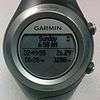 |
| Forerunner 60 | 2009-01-30[22] | |
| Forerunner 405CX | 2009-04-02[23] |
|
| Forerunner 310XT | 2009-04-02[24] | 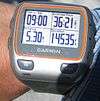 |
| Forerunner 110 | 2010-03-29[25] | |
| Forerunner 210 | 2010-10-04[26] |  |
| Forerunner 410 | 2010-10-04[26] | |
| Forerunner 610 | 2011-04-12[27] |  |
| Forerunner 910XT | 2011-10-04[28] | |
| Forerunner 10 | 2012-08-28[29] |  |
| Forerunner 220 | 2013-09-16[30] |
|
| Forerunner 620 | 2013-09-16[30] | |
| Forerunner 15 | 2014-05-06[31] | |
| Forerunner 920XT | 2014-10-01[32] |
|
| Forerunner 225 | 2015-05-12[13][14] |
|
| Forerunner 230 | 2015-10-21[33] |
|
| Forerunner 235 | 2015-10-21[34] |
|
| Forerunner 630 | 2015-10-21[35] | |
| Forerunner 735XT | 2016-05-11[36] | |
References
- ↑ Rebecca Viksnins (22 June 2004). "Garmin Forerunner 201 review - CNET". Retrieved 3 October 2014.
- ↑ "Trademark Electronic Search System (TESS) - FORERUNNER". United States Patent and Trademark Office. Retrieved 3 October 2014.
- ↑ "Garmin Forerunner 50". gpsreview.net. Retrieved 3 October 2014.
- ↑ Mat Honan (26 May 2009). "Garmin Forerunner 310XT - New Garmin Is Hands-Down King of Wrist-Mounted Trainers". Retrieved 3 October 2014.
- ↑ "The New Garmin Forerunner 310XT Openwater Swim Mode…In Depth.". DC Rainmaker. Retrieved 3 October 2014.
- ↑ Gary Roethenbaugh (5 October 2010). "Garmin adds to 410 and 210 to Forerunner family". Retrieved 3 October 2014.
- ↑ "Forerunner 610 - Garmin". Garmin. Retrieved 3 October 2014.
- ↑ "Forerunner 910XT - Garmin". Garmin. Retrieved 3 October 2014.
- ↑ "Forerunner 220 - Garmin". Garmin. Retrieved 3 October 2014.
- ↑ "Forerunner 620 - Garmin". Garmin. Retrieved 3 October 2014.
- ↑ "Forerunner 15 - Garmin". Garmin. Retrieved 3 October 2014.
- ↑ "Forerunner 920XT - Garmin". Garmin. Retrieved 3 October 2014.
- 1 2 "Introducing the Forerunner® 225 – the first Garmin® GPS running watch with wrist-based heart rate from Mio, developers of industry-leading optical heart rate technology". Garmin. Retrieved 12 May 2015.
- 1 2 "Garmin Forerunner 225: Wearable with Optical Heart Rate Sensor".
- ↑ https://buy.garmin.com/en-GB/GB/sports-recreation/running/forerunner-735xt/prod541225.html#.VVIkN_lViko/. Missing or empty
|title=(help) - ↑ "Garmin® Unveils Low-Cost, GPS Fitness Product — the Forerunner™ 101". Garmin. Retrieved 3 October 2014.
- ↑ "Garmin® Unveils GPS-Enabled Forerunner™ 201 Personal Training System". Garmin. Retrieved 3 October 2014.
- ↑ "Garmin® Keeps Athletes in 'Optimal Zone' with Forerunner™ 301". Garmin. Retrieved 3 October 2014.
- 1 2 "Garmin's® New Forerunners® Give Outdoor Fitness a New Look". Garmin. Retrieved 3 October 2014.
- ↑ "Garmin® Introduces Forerunner® 50 As Only Sports Watch With Automatic Wireless Sync". Garmin. Retrieved 3 October 2014.
- ↑ "Garmin® Blends Fitness, Fashion and Function in Forerunner® 405". Garmin. Retrieved 3 October 2014.
- ↑ "Sleek and Simple to Use, Garmin® FR60 Fitness Watch Gets You Connected On the Road, In the Gym". Garmin. Retrieved 3 October 2014.
- ↑ "Garmin® Makes Every Calorie Count with New Forerunner® 405CX". Garmin. Retrieved 3 October 2014.
- ↑ "Garmin® Gives Fitness a Facelift with Forerunner® 310XT, the Waterproof Multi-Sport Watch with Longer Battery Life". Garmin. Retrieved 3 October 2014.
- ↑ "Garmin® Forerunner® 110 Simplifies and Streamlines GPS for Runners". Garmin. Retrieved 3 October 2014.
- 1 2 "Garmin® Expands Forerunner® Family, Giving Runners More GPS Options". Garmin. Retrieved 3 October 2014.
- ↑ "Garmin® Adds Its First Touchscreen GPS Watch to Forerunner® Family". Garmin. Retrieved 3 October 2014.
- ↑ "The Ultimate Multisport Training Experience: Garmin® Forerunner® 910XT". Garmin. Retrieved 3 October 2014.
- ↑ "Every Mile Matters with the Garmin® Forerunner® 10 GPS for Runners". Garmin. Retrieved 3 October 2014.
- 1 2 "There's A Coach In Every Watch— Garmin® Forerunner® 620 and 220 With Color Display". Garmin. Retrieved 3 October 2014.
- ↑ "Introducing Garmin® Forerunner® 15: A GPS Running Watch with Heart Rate and Daily Activity Tracking". Garmin. Retrieved 3 October 2014.
- ↑ "Introducing the Forerunner® 920XT from Garmin® – a multisport GPS watch with advanced running dynamics and connected features". Garmin. Retrieved 3 October 2014.
- ↑ "Train smarter with the latest GPS running watches from Garmin® – Introducing the Forerunner® 230 and 235 and Garmin Elevate™ wrist heart rate technology". Garmin. Retrieved 21 October 2015.
- ↑ "Train smarter with the latest GPS running watches from Garmin® – Introducing the Forerunner® 230 and 235 and Garmin Elevate™ wrist heart rate technology". Garmin. Retrieved 21 October 2015.
- ↑ https://www.dcrainmaker.com/2015/12/garmin-forerunner-630-depth-review.html
- ↑ "Announcement: Forerunner 735XT". Garmin. Retrieved 19 July 2016.
External links
| Wikimedia Commons has media related to Garmin Forerunner. |

